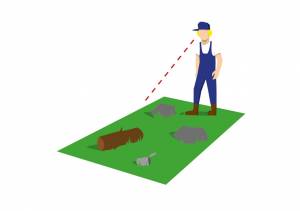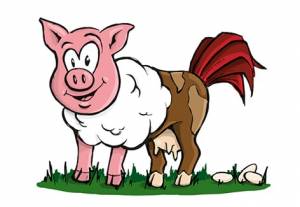Combating giant hogweed with AS-Motor’s remote-controlled ride-on mower AS 940 Sherpa 4WD RC
Controlling giant hogweed is a major challenge. Due to its rapid proliferation, the plant endangers native vegetation while skin contact with giant hogweed can cause photo-toxic reactions and thus severe skin burns. AS-Motor’s remote-controlled AS 940 Sherpa 4WD RC allows users to combat giant hogweed populations safely and efficiently.
Giant hogweed, a health hazard and an ecological threat
Giant hogweed’s various species (Heracleum mantegazzianum, Heracleum sosnowskyi, Heracleum persicum) originate in the Caucasus, Turkey, Iran and Iraq. Giant hogweed was introduced to Europe in the 19th century as an ornamental crop and has now spread over most of the continent. Giant hogweed stores nutrients in tap roots and forms flowers and seeds as soon as sufficient reserves are present. The single flowering, herbaceous plant usually blooms in its third to fifth year of life, which in Central Europe occurs between June and July. The plant’s numerous individual flowers form a cone with up to 50,000 highly germinating seeds, making the giant hogweed’s reproduction potential enormous. After flowering, the plant dies and its seeds are spread by wind, water and human beings. The seeds are ready to germinate after flowering in spring and remain germinable for up to 10 years.
While all parts of the plant are toxic, the clear, aqueous sap from inside the plant contains photo-sensitizing substances (furanocoumarins) that, in combination with UV radiation, can cause severe skin burns (phytophotodermatitis) in humans. Native vegetation suffers in biodiversity and biodensity from the giant hogweed as these plants are forced to compete for light and water with an herbaceous perennial that grows up to 4 meters high. Giant hogweed populations can also cause erosion damage in shore zones as their roots do not have a shore-stabilising function.
Remote-controlled mower for optimal user safety
Various control measures are used to combat giant hogweed and to prevent its further proliferation. Manual and mechanical measures include the use of herbicides and grazing, or cutting off the root and thus the vegetation cone, which causes the plant to die. Other control measures include removing the umbels, digging out the plant and mowing with a trimmer or lawn mower. In all the above, however, the user is in direct contact with the plant and therefore exposed to a high health risk.
AS-Motor offers a remote-controlled ride-on mower to safely combat giant hogweed populations. The AS 940 Sherpa 4WD RC can be conveniently and precisely operated from outside the danger area via a professional remote-control unit with a range of up to 300 meters. A low centre of gravity and optimal propulsion qualify the device for mulching on difficult and steep terrain. The AS 940 Sherpa 4WD RC offers additional user protection thanks to its closed mowing deck.
Combating large populations of giant hogweed
Digging out individual giant hogweed plants or cutting their roots is a time-intensive process, making mulching the most efficient measure for large populations. In the first year of control, cutting should occur shortly before flowering when the plant can be weakened the most. If the plant grows high, which is usually the case, it is advisable to first clear the plants at a high cutting level and then mow a second time on the level closest to the ground. After this first mowing, regular mulching during the entire vegetation period is necessary since the plant grows back. As the plant can bear blossoms and form seeds starting from a height of 10 cm, mowing is necessary approximately every ten days depending on the weather. From the second year of control onward, mowing should take place as early as possible in the growing season and be repeated regularly at intervals of approximately ten days. Mulching withdraws energy from the plant until it finally dies. Overall, it may be necessary to repeat this procedure for up to ten years. The area must be checked regularly to ensure that all plants are dead and that seeds are no longer germinable.
Combating small populations of giant hogweed
Control procedures may differ for smaller populations:
- It is advisable to mulch the plant first
- then cut the root 15 cm below the ground, with a spade for example
- the surface should then be covered with a black tarp to suppress seed germination. Nevertheless, regular inspection of the area is required in order to control seedlings
- Cleaning of the machine with appropriate protective clothing (see below)
Cleaning of the machine to protect the user
Appropriate protective clothing is essential even if the user operates the remote-controlled mower from a safe distance and is thus protected from direct contact and spraying of plant sap. In this case protective clothing means a full-body coverall with hood, protective goggles, rubber gloves and boots. This is especially important for the subsequent cleaning of the machine.
After each use, a thorough cleaning of the machine is necessary. The device should be loaded onto a transport vehicle via remote control. If a person comes into contact with sap on the machine, photo-toxic reactions can occur even some time after use. To clean the machine, it is recommended to apply vinegar cleaner (with not more than 10% acetic acid) while wearing protective clothing and to clean the machine using a strong water jet (not a high-pressure cleaner, particularly due to the increased risk of splashing) and a brush.


